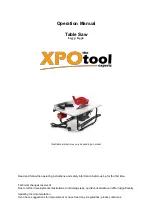
5
English
The label on your tool may include the following symbols. The
symbols and their definitions are as follows:
V ......................... volts
Hz .......................hertz
min .....................minutes
or DC ......direct current
...................... Class I Construction
(grounded)
…/min ..............per minute
BPM ....................beats per minute
IPM .....................impacts per minute
RPM .................... revolutions per
minute
sfpm ................... surface feet per
minute
SPM ....................strokes per minute
OPM .................... oscillations per
minute
A .........................amperes
W ........................watts
or AC ...........alternating current
or AC/DC .... alternating or
direct current
...................... Class II
Construction
(double insulated)
no .......................no load speed
n .........................rated speed
......................earthing terminal
.....................safety alert symbol
.....................visible radiation
..................... avoid staring at
light
..................... wear respiratory
protection
..................... wear eye
protection
..................... wear hearing
protection
..................... read all
documentation
IPXX .................... IP symbol
•
An extension cord must have adequate wire size
(AWG or American Wire Gauge) for safety.
The
smaller the gauge number of the wire, the greater the
capacity of the cable, that is, 16 gauge has more capacity
than 18 gauge. An undersized cord will cause a drop in
line voltage resulting in loss of power and overheating.
When using more than one extension to make up the
total length, be sure each individual extension contains at
least the minimum wire size. The following table shows
the correct size to use depending on cord length and
nameplate ampere rating. If in doubt, use the next heavier
gauge. The lower the gauge number, the heavier the cord.
Minimum gauge for Cord sets
Volts
Total length of Cord in Feet
(meters)
120 V
25 (7.6)
50 (15.2) 100 (30.5) 150 (45.7)
240 V
50 (15.2) 100 (30.5) 200 (61.0) 300 (91.4)
Ampere Rating
American Wire gauge
More
Than
not
More
Than
0
6
18
16
16
14
6
10
18
16
14
12
10
12
16
16
14
12
12
16
14
12
Not Recommended
To Reduce the Risk of Kickback
• Keep a firm grip on saw with both hands at all times.
• Stay alert – exercise control.
• Support long overhanging materials. As the material is cut
and weakens, it will sag, causing a pinched blade.
• Support large panels. Material supported only at the ends
will lead to blade pinching.
Fig. B
• Avoid sawing overhead. Material can sag and will
pinch blade.
Fig. C
• Insure that the material to be cut is clamped and solidly
supported and balanced on a strong, stable and level
work surface. Support the work so that the wide portion
of the saw shoe is on the portion of the material that
doesn’t fall after the cut is made. Never hold cut off piece
by hand.
Fig. D
Fig. E
• Keep blades sharp and clean.
• Use fence or straight edge guide when ripping. Be careful
as the cut off strip can sag or twist, closing the cut and
pinching the blade, leading to KICKBACK.
• Don’t force tool. Wood variables such as knots, hardness,
toughness, wetness, pressure treated and freshly cut
green lumber can heavily load the saw which can lead to
stalling. Push the saw slower when this occurs.
• Don’t remove saw from work during a cut while the blade
is moving.
• Allow saw to reach full speed before blade contacts
material to be cut. Starting the saw with the blade








































